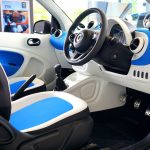Digital twin technology has rapidly transformed the landscape of automotive design, ushering in a new era of innovation and efficiency. In this article, we will delve into the various facets of digital twin applications in the automotive industry, exploring their impact on virtual car prototyping, simulation of vehicle performance, manufacturing processes, and design efficiency enhancement.
Introduction
Digital twin technology involves creating a virtual replica or representation of a physical object or system, using real-time data and simulation. In the realm of automotive design, this technology has proven to be a game-changer, offering designers and engineers unprecedented insights and capabilities.
Virtual Car Prototyping
Virtual car prototyping involves the creation and testing of virtual models of vehicles before the production of physical prototypes. This not only saves substantial time but also significantly reduces costs associated with traditional prototyping methods. Imagine being able to tweak and refine the design of a car without the need for extensive physical iterations.
Advantages of Virtual Car Prototyping
The advantages of virtual car prototyping are manifold. Firstly, it allows for quick and iterative design changes. Designers can experiment with different shapes, sizes, and functionalities in a virtual environment, accelerating the design process. Secondly, the cost savings are substantial, as there’s no need to create multiple physical prototypes for testing.
Real-World Examples
Companies like Tesla have been at the forefront of adopting virtual car prototyping. Tesla’s ability to continuously improve and update its vehicle models is, in part, due to the extensive use of digital twin technology. This has not only reduced time-to-market but has also contributed to the company’s reputation for cutting-edge design.
Simulating Vehicle Performance
Simulation of vehicle performance is another critical aspect of digital twin technology in automotive design. This involves creating digital replicas of vehicles and subjecting them to various simulated conditions to analyze their performance.
Role of Digital Twins in Performance Simulation
Digital twins allow engineers to simulate different scenarios, such as extreme weather conditions, terrain variations, and performance under high speeds. This level of simulation provides valuable insights into how a vehicle will perform in the real world, enabling designers to make data-driven decisions.
Benefits of Performance Simulation
The benefits of simulating vehicle performance are evident in terms of safety, optimization, and efficiency. Identifying potential issues in a controlled digital environment helps prevent design flaws that could pose risks to drivers and passengers. Optimization of performance based on simulations contributes to fuel efficiency and overall sustainability.
Case Studies
BMW is a notable example of a company leveraging digital twin technology for performance simulation. The German automaker extensively uses digital twins to simulate the aerodynamics and performance of their vehicles. This has not only enhanced the safety of their cars but has also contributed to the development of more fuel-efficient models.
Digital Twin Applications in Manufacturing
The impact of digital twin technology extends beyond the design phase into the manufacturing process. Companies in the automotive industry are utilizing digital twins to streamline production and minimize errors.
Streamlining Production
Digital twins provide a real-time view of the manufacturing process, allowing for constant monitoring and optimization. This results in more efficient production lines, reduced downtime, and ultimately, cost savings. The ability to identify and address issues in real-time minimizes the risk of faulty products reaching the market.
Examples of Automotive Companies
Ford has embraced digital twin technology in its manufacturing processes. By creating digital replicas of its production lines, Ford can identify bottlenecks, optimize workflows, and enhance overall efficiency. This has translated into higher productivity and improved quality control.
Enhancing Design Efficiency with Digital Twins
One of the key benefits of digital twins in automotive design is the enhancement of design efficiency. This goes beyond the prototyping phase and extends to the collaboration among design teams.
Contribution to Better Design Outcomes
Digital twins facilitate collaboration by providing a shared digital space where design teams can work together seamlessly. Changes made by one team member are reflected in real-time, ensuring that everyone is on the same page. This contributes to better design outcomes and reduces the likelihood of errors.
Real-World Success Stories
Companies like General Motors have seen remarkable improvements in design efficiency through the use of digital twin technology. The ability to collaborate across geographical locations has allowed GM to tap into a global pool of talent, resulting in innovative and efficient design solutions.
Challenges and Solutions in Implementing Digital Twins
While the benefits of digital twin technology are substantial, implementing it comes with its set of challenges. Addressing these challenges is crucial for the successful integration of digital twins into automotive design processes.
Common Challenges
Some common challenges include the complexity of setting up digital twin systems, the need for high-quality real-time data, and the resistance to change within organizations. Overcoming these challenges requires a strategic approach and a commitment to training and education.
Solutions and Best Practices
Companies that have successfully implemented digital twins have focused on comprehensive training programs for their teams. Additionally, investing in robust data infrastructure and establishing clear protocols for data management are essential. Embracing a culture of adaptability and continuous learning is key to overcoming resistance to change.
Future Trends in Digital Twin Technology for Automotive Design
As technology continues to evolve, so does the landscape of digital twin applications in automotive design. Several emerging trends complement and expand the capabilities of digital twin technology.
Emerging Technologies
The integration of artificial intelligence (AI) and machine learning (ML) is poised to revolutionize digital twin applications. AI can analyze vast amounts of data, providing more accurate insights and predictions. This opens up new possibilities for enhancing design, performance simulation, and manufacturing processes.
Predictions for the Future
Experts predict a more widespread adoption of digital twin technology across the automotive industry. As the technology becomes more accessible and user-friendly, smaller companies are likely to embrace it, leading to increased competition and innovation.
Impact on Automotive Industry
The impact of digital twin technology on the automotive industry is profound, with far-reaching implications for design, production, and overall competitiveness.
Overall Impact
Digital twin technology has not only accelerated the design and manufacturing processes but has also contributed to a higher level of innovation. Companies that leverage digital twins gain a competitive edge by bringing products to market faster and with higher quality.
Statistics and Market Trends
According to market research, the global digital twin market in the automotive sector is expected to grow significantly in the coming years. This growth is driven by the increasing recognition of the technology’s benefits, such as cost savings, efficiency improvements, and better design outcomes.
Case Studies: Successful Implementation
Examining specific cases where digital twin technology has led to successful automotive designs provides valuable insights for industry professionals and enthusiasts alike.
Tesla’s Approach to Digital Twins
Tesla’s use of digital twins extends beyond virtual car prototyping. The company employs digital twins in its vehicle software, allowing for real-time updates and improvements. This approach has contributed to Tesla’s reputation for producing vehicles with cutting-edge technology and features.
BMW’s Aerodynamic Simulations
BMW’s utilization of digital twins for aerodynamic simulations has led to the development of more fuel-efficient and environmentally friendly vehicles. The ability to simulate and optimize aerodynamics in a digital environment has become a hallmark of BMW’s commitment to sustainability.
Digital Twins and Sustainable Design
The role of digital twins in promoting sustainable design practices cannot be overstated. By enabling virtual testing and optimization, digital twins contribute to reducing the environmental impact of automotive design.
Environmental Benefits
Digital twins help minimize the need for physical prototypes and extensive testing, reducing waste and resource consumption. This aligns with the growing emphasis on sustainability within the automotive industry and society at large.
Eco-Friendly Aspects
Companies like Toyota are incorporating digital twin technology into their sustainability initiatives. By using digital twins to optimize manufacturing processes, Toyota aims to reduce its carbon footprint and contribute to global environmental goals.
User Experience and Digital Twins in Automotive Design
In addition to improving design efficiency and performance, digital twins play a crucial role in enhancing the overall user experience in automotive design.
Feedback and Insights
Digital twins allow designers to gather real-time feedback from users, incorporating their insights into the design process. This iterative approach ensures that the final product aligns with user expectations and preferences.
User-Centric Design
Automakers like Mercedes-Benz emphasize a user-centric design approach, facilitated by digital twin technology. By understanding the needs and preferences of users through digital simulations, Mercedes-Benz delivers vehicles that not only perform well but also resonate with the end-users.
Security and Privacy Concerns
While the benefits of digital twin technology are substantial, it’s essential to address potential security and privacy concerns associated with its implementation.
Ensuring Security
Securing the data used in digital twin simulations is a top priority. Companies invest in robust cybersecurity measures to protect sensitive information and prevent unauthorized access. This includes encryption, secure data storage, and regular security audits.
Privacy Measures
Ensuring the privacy of users involved in digital twin simulations is equally crucial. Companies adhere to strict privacy policies and anonymize data whenever possible to safeguard the personal information of users participating in the design and testing processes.
Adoption Rates in the Automotive Industry
Analyzing the current adoption rates of digital twin technology in the automotive sector provides insights into its trajectory and potential future growth.
Current Landscape
While major players like Tesla, BMW, and Ford have embraced digital twin technology, the overall adoption rate in the industry varies. Larger companies with substantial resources have led the way, but as technology becomes more accessible, smaller companies are expected to join the digital twin revolution.
Factors Influencing Adoption
The cost of implementing digital twin technology and the readiness of organizations to embrace change are significant factors influencing adoption rates. Companies that invest in training, infrastructure, and cultural shifts are more likely to successfully adopt and benefit from digital twin technology.
Comparative Analysis with Traditional Design Methods
Contrasting digital twin technology with traditional design methods highlights the advantages that set digital twins apart.
Speed and Flexibility
Digital twins offer unparalleled speed and flexibility in design and testing. Traditional methods often involve lengthy processes of creating physical prototypes and conducting extensive tests, whereas digital twins allow for rapid iterations and adjustments.
Cost-Efficiency
The cost-efficiency of digital twin technology is a major advantage. Traditional methods incur substantial costs in creating multiple physical prototypes, conducting tests, and addressing design flaws. Digital twins streamline these processes, resulting in significant cost savings.
Conclusion
In conclusion, digital twin technology has ushered in a new era of innovation in automotive design. From virtual car prototyping to simulating vehicle performance, enhancing design efficiency, and promoting sustainable practices, digital twins have become integral to the industry. As technology continues to evolve, the adoption of digital twins is poised to grow, bringing about further advancements and efficiencies.
FAQs:
Is digital twin technology only applicable to large automotive companies?
No, while larger companies have led the adoption, digital twin technology is becoming more accessible, and smaller companies can benefit from its applications.
How does digital twin technology contribute to sustainable automotive design?
Digital twins reduce the need for physical prototypes, minimizing waste and contributing to environmentally friendly design practices.
What are the main security measures in place for protecting digital twin data?
Security measures include encryption, secure data storage, and regular security audits to prevent unauthorized access.
Can digital twin simulations accurately predict real-world vehicle performance?
Yes, digital twin simulations, when based on accurate data, provide a reliable indication of real-world vehicle performance.
How does user feedback play a role in the design process with digital twin technology?
Digital twins allow designers to gather real-time user feedback, shaping the design process to meet user expectations.
Last Updated on December 2, 2023 by admin

Mac is an Automotive enthusiast. He owns up to 15 vehicles. He deals with Auto problems and shows his skill to Car owners who are seeking any type of Car help.





